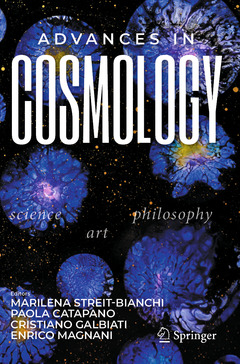Advances in Cosmology, 1st ed. 2022 Science - Art - Philosophy
Coordonnateurs : Streit-Bianchi Marilena, Catapano Paola, Galbiati Cristiano, Magnani Enrico

Part 1: From Astronomy to Modern Cosmology.- Chapter 1 - Looking at the sky: from Galileo to Newton to Einstein (Ugo Moschella).- Chapter 2 - Cosmological thinking from myths to science (cosmology in emerging quantum mechanics) (Gabriele Veneziano).- Chapter 3 - Modern cosmological theories (Kai Schmitz).- Part 2: Search of dark matter, dark energy, Black Holes, star formation and other cosmological searches.- Chapter 4 - Introduction on CERN search of Dark Matter and other searches relevant for astrophysics (Suchita Kulkarni).- Chapter 5 - Searching for Dark matter with the ATLAS detector (Caterina Doglioni and Dan Tovey).- Chapter 6 - Searching for Dark matter with the CMS detector (Deborah Pinna).- Chapter 7 - Probing Stealth Dark Sectors with LHCb (Carlos Vázquez and José Zurita).- Chapter 8 - Hunting Dark Matter Axions with CAST (Marios Maroudas and Kaan Ozbozduman).- Chapter 9 - FASER: the lifetime frontier at the LHC and the search for dark matter (Michaela Queitsch-Maitland).- Chapter 10 – BASE Testing Fundamental Symmetrics with High Precision Comparisons of the Properties of Antiprotons and Protons (Stefan Ulmer).- Chapter 11 – NA64 Search for Dark Sector Particles (Dipanwita Banerjee).- Part 3: Space searches.- Chapter 12 – The AMS experiment on the International Space Station (Maura Graziani and Nicola Tomassetti).- Chapter 13 – The right key-Four spacewalks to repair the Alpha Magnetic Spectrometer on the International Space Station (Claudio Bortolin and Paola Catapano).- Part 4: Gravitational waves.- Chapter 14 – Gravitational Waves: Why and How (Federico Ferrini).- Part 5: Underground Discovery of Dark Matter.- Chapter 15 – Under the Gran Sasso (Cristiano Galbiati and Walter Bonivento).- Part 6: Optical Astronomy.- Chapter 16 – Big telescopes and observatories: hi-tech challenges for great astronomical science (Gianni Marconi and Riccardo Scarpa).- Chapter 17 – Other worlds in the cosmos: from philosophy to scientific reality (Michel Mayor, Emeline Bolmont, Vincent Bourrier, David Ehrenreich and Christoph Mordasini).- Part 7: Philosophy.- Chapter 18 – Space, time and matter in the primordial Universe (Francesca Vidotto).- Part 8: Art.- Chapter 19 – The shore between Art and Science (Enrico Magnani).
Marilena Streit-Bianchi received a doctorate in Biological Sciences from the University of Rome and joined CERN, the European Organization for Nuclear Research in Geneva (Switzerland), in 1969. She has been a pioneer in the study of high-energy particles produced by accelerators for cancer treatment. She has held managerial positions on safety training and technology transfer, has been a senior honorary staff member at CERN, and is actively engaged in art and science as a book editor and curator of exhibitions in Europe and Mozambique. She is the vice president of the international association ARSCIENCIA and a member of the Italian Physics Society (SIF). She has been one of the editors of the book “Mare Plasticum-The Plastic Sea -Combatting Plastic Pollution Through Science and Art”, published by Springer.
Paola Catapano is a science journalist and science communicator. In 1987 she graduated in simultaneous interpreting from the University of Trieste and in 1997 she obtained a master’s degree in Science Journalism from SISSA (International School for Advanced Studies), Trieste. At CERN since 1990, she is currently head of the editorial content production in CERN’s Education, Communication and Outreach group. In 2010-11, she authored and hosted the TV program DIXIT Science for the Italian National Television, RAI. She has created and led the research expedition to the Arctic Polarquest2018, whose program included historical exploration, measurements of cosmic rays, drone mapping of uncharted territories, and plastic debris sampling until the 82°nd parallel (conferences and book “Mare Plasticum-The Plastic Sea -Combatting Plastic Pollution Through Science and Art”). She has participated in several Science Festivals, and won international awards.
Date de parution : 12-2023
Ouvrage de 376 p.
15.5x23.5 cm
Date de parution : 12-2022
Ouvrage de 376 p.
15.5x23.5 cm
Thèmes d’Advances in Cosmology :
Ces ouvrages sont susceptibles de vous intéresser

Deconstructing Cosmology 40,18 €

Classical and Quantum Cosmology 94,94 €

